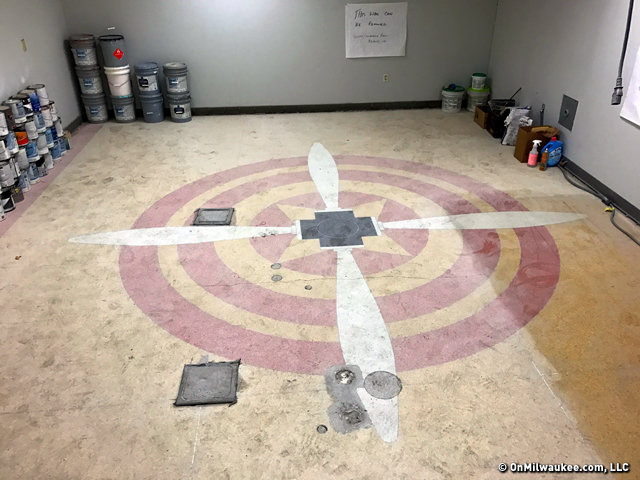Let me just say up front that I love tips from readers and friends. Tips like this one I got last week: "Knowing you, you already know about this. In case you don't: There is a helicopter in the floor of the old A.O. Smith plant."
A helicopter in the floor? I didn’t know anything about this but, of course, I needed to know more. Turns out, my friend didn’t mean the old A.O. Smith plant on Milwaukee’s North Side, which I wrote about here.

She meant a sprawling plant built by the Department of Defense during World War II, at which A.O. Smith was tapped to make propellers for fighter planes. And so, one cool, sunny morning recently, I met up with Mike Schneider, president of U-Haul Wisconsin, which now owns the property.

Schneider and his general manager Ken Heitman showed me around the plant. At the outset, Heitman said, "shall we save the best for last"?
And we began to walk. And walk. And walk. Because this place is huge.
We saw outsized work sheds.
We saw a former powder coating building that now houses huge containers U-Haul rents to folks who need to ship large items great distances.

A.O. Smith's continued presence on the site: a water heater.
We saw sparkling clean self-storage areas whose floors were once coated thick with machine oil that had long since been swallowed up by petroleum-munching microbes.
We saw boilers and fan rooms and locker rooms and tunnels that served as bomb shelters (pictured below) back when this was a defense department building.
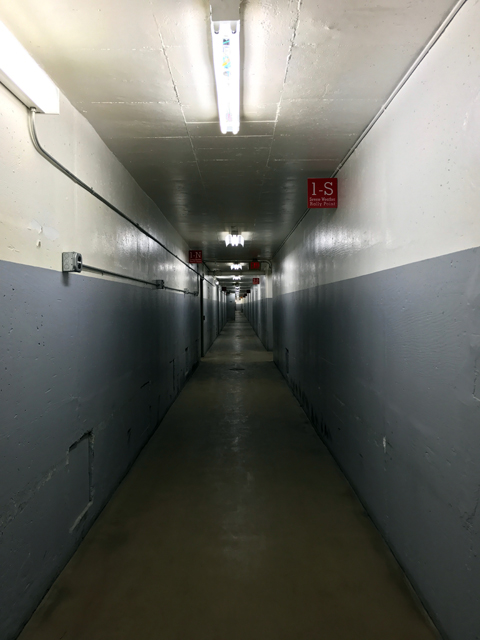
In 1943, the federal government broke ground on 117th Street and Capitol Drive – then out in the middle of nowhere – for a plant that was completed the following year.
A.O. Smith has its roots in a bicycle and baby carriage company founded by Charles Jeremiah Smith in 1874. Under the guidance of Smith’s son Arthur Oliver, the company began making vehicle frames in 1899 and five years later the company became A.O. Smith. In 1910 it was making more car frames than anyone else in the country.

During the war, A.O. Smith made torpedo casings and aircraft landing gear, according to Meg Jones’ "World War II Milwaukee," who notes that, "the second-largest defense plant in Milwaukee (after Allis-Chalmers), A.O. Smith made more bombs than any other U.S. company by the end of World War II."
The company also, "welded steel propeller blades for P-47 Thunderbolts and other fighter planes. By the end of 1945, A.O. Smith had produced 46,700 propeller blades for military aircraft."

When the war ended, the enormous, 400,000-square foot plant was mothballed by the Defense Plant Corp. In 1947, it was purchased by Harley-Davidson, which manufactured motorcycle engines here until 2011.
Harley moved its engine operation to the Pilgrim Road plant in Menomonee Falls when it shuttered the Capitol Drive factory, but the motorcycle maker’s research and development facility is still located just north of the Capitol plant.
The site was also the birthplace of the Harley-Davidson Museum, which now has much more expansive and elaborate digs in the Menomonee Valley.
When it left, Harley employees left behind a wide variety of items that are now part of a thoroughly informal Harley Museum that still exists on the site. Actually it’s probably better described as an old office with some Harley-era stuff: some magazines, an old employee directory, parts of an engine found stuffed into some employee’s locker downstairs (hmmm), a pair of Harley boots.

The most intriguing items are what appear to be an early architectural rendering of what might be Harley’s Juneau Avenue facility and a floor plan of the Capitol Drive plant showing every single work station. In the old museum space you can still see some tire tread marks on the floor and the old auditorium space. But every remnant of the Harley logo was scrubbed clean when the company left.
 All the Harley-Davidson logos were removed from the building.
All the Harley-Davidson logos were removed from the building.
One other feature that survives from the Harley era are the light fixtures (pictured below) that are now in the showroom of the U-Haul business that occupies the site.

U-Haul International bought the property and moved in in April 2015. Schneider says it took some convincing, but the fact that so many operations – including the company’s local vehicle maintenance and repair shop – could be consolidated on the site sealed the deal.
"That was part of me selling the idea to the CEO," Schneider recalled, "how are we going to utilize the space, it is too much? We moved the operations over here and we freed up some space at another facility."
The purchase also fits with U-Haul’s philosophy of adaptive reuse of old buildings, Schneider said.
"We’re really trying to keep the history alive here," said Schneider, who grew up nearby and had many memories of the Harley plant on the site.

But, what of the helicopter?
Schneider said when U-Haul moved in, he introduced himself to the operations manager at the Harley plant next door.
"We were sitting down, we were saying, ‘hey, if we do anything we'll let you know, you let us know. Let's be good neighbors.’ He goes, ‘And by the way, did you find the helicopter propeller yet?’ I'm like, ‘What?’ That's the first time I heard of it. I go ‘No, what do you know about it?’ They go, ‘I don't know, we don't even know if it exists’."
And so began the search.
"It was a quest and we're trying to figure it out and we were looking everywhere and we started talking to people and we heard stories. Ken had a guy that worked here, Mark, that said, ‘They walked over it when they came into work, because it was the main entrance.’ It was the employee entrance for the propeller plant would walk in and walk across that when they came into the plant."
Using some old electrical drawings and a system of numbers and letters used to identify locations on a grid inside the giant facility (A1, B2, etc.), Schneider and Heitman surmised the location of the old entrance and they set to work.
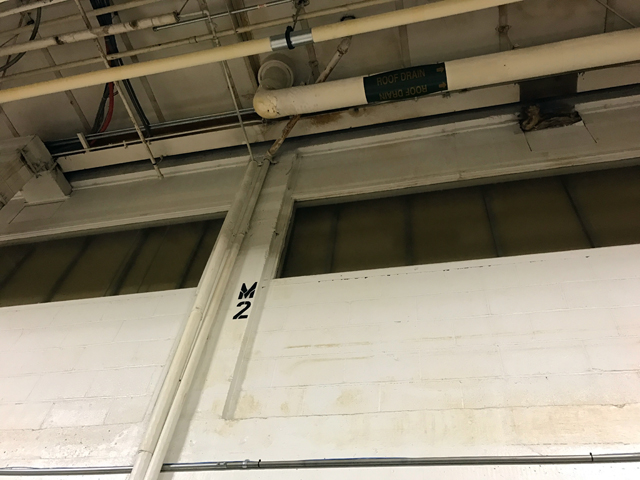
"We start jack hammering around here," Schneider said. "We jack hammer and we get lucky and all of a sudden we looked and we're like, ‘holy crap.’ There was an inch of concrete and then hard tile and then soft tile on top of that and then another tile on top of that. It was like four generations down."
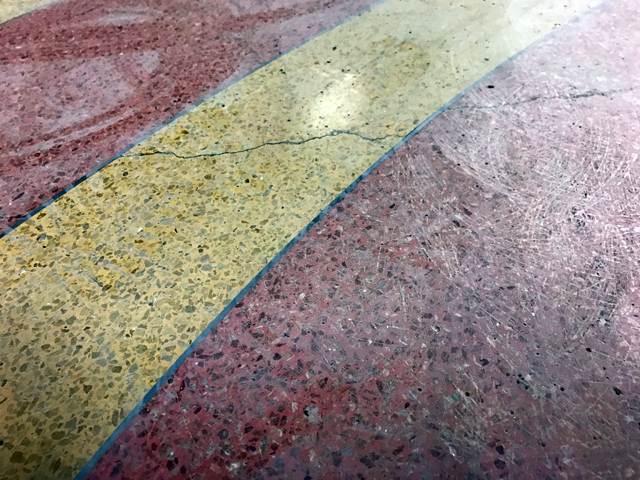
What IT was wasn’t a helicopter, nor was it an actual propeller in the floor, but rather a beautiful terrazzo propeller set inside the center of a series of red and yellow concentric circles suggesting the movement of the four blades. Each section is outlined with a strip of shiny aluminum.
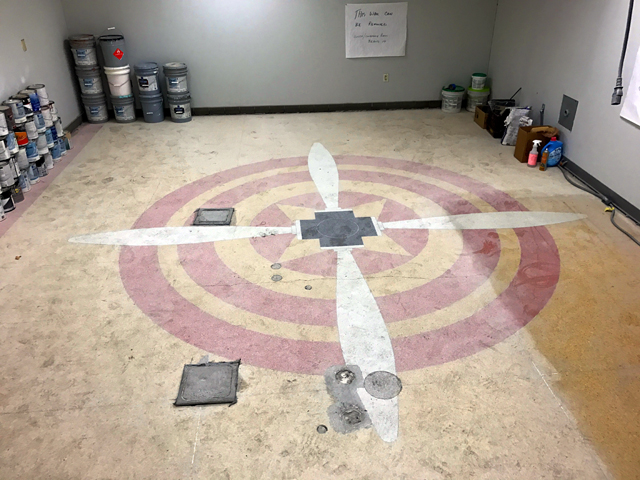
Along with the lobby of the old A.O. R&D building up on Milwaukee’s North Side, this is one of the most striking examples of Art Deco in the area. And the fact that while a war was raging and Milwaukeeans were working hard to build war materials, there was still an attention to aesthetics and detail when the factory was being built.
Perhaps the builders understood that seeing something beautiful every morning on their way into work would make employees want to work that much harder.
The propeller was uncovered about nine months ago and the work to remove all the layers above it lasted about two months.
"It was pretty exciting when Ken called me and said we found it," Schneider said. "It was like, ‘yes!’"
Heitman recalled Schneider’s response to the news: "What do you mean it's not a real propeller? What the heck is it?"
Schneider and Heitman did a little cleaning and polishing of a section to see how the entire floor would look and the results were encouraging.

New life for a sprawling old building.
Sadly, because the floor had been mostly forgotten underneath all those layers, work done in the intervening years has resulted in seven areas where the terrazzo has been harmed, and a long crack running along through the design, but these all appear to be reparable.
At the moment, there’s no immediate plan to restore it and the room is currently unused. But that could change, and these guys clearly appreciate the beauty and understand the historical significance of what they own.
"We've already gotten prices on it," Schneider said. "We just don't know what to do with it at this point, so we're holding off. But we'll probably end up doing it at some point. We uncover it, we keep it and hopefully one day in the future we'll figure out what we're going to do with this."
Born in Brooklyn, N.Y., where he lived until he was 17, Bobby received his BA-Mass Communications from UWM in 1989 and has lived in Walker's Point, Bay View, Enderis Park, South Milwaukee and on the East Side.
He has published three non-fiction books in Italy – including one about an event in Milwaukee history, which was published in the U.S. in autumn 2010. Four more books, all about Milwaukee, have been published by The History Press.
With his most recent band, The Yell Leaders, Bobby released four LPs and had a songs featured in episodes of TV's "Party of Five" and "Dawson's Creek," and films in Japan, South America and the U.S. The Yell Leaders were named the best unsigned band in their region by VH-1 as part of its Rock Across America 1998 Tour. Most recently, the band contributed tracks to a UK vinyl/CD tribute to the Redskins and collaborated on a track with Italian novelist Enrico Remmert.
He's produced three installments of the "OMCD" series of local music compilations for OnMilwaukee.com and in 2007 produced a CD of Italian music and poetry.
In 2005, he was awarded the City of Asti's (Italy) Journalism Prize for his work focusing on that area. He has also won awards from the Milwaukee Press Club.
He has be heard on 88Nine Radio Milwaukee talking about his "Urban Spelunking" series of stories, in that station's most popular podcast.

